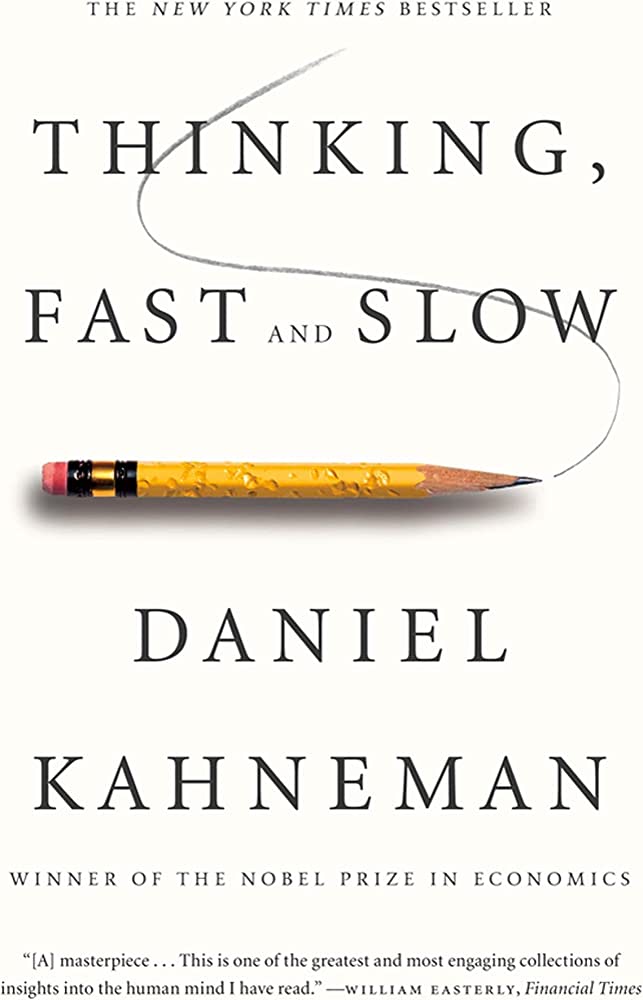
Thinking Fast and Slow
Daniel Kahneman
★★★★★
A reliable way to make people believe in falsehoods is frequent repetition, because familiarity is not easily distinguished from truth.
Location: 1055The familiarity of one phrase in the statement sufficed to make the whole statement feel familiar, and therefore true.
if your message is to be printed, use high-quality paper to maximize the contrast between characters and their background. If you use color, you are more likely to be believed if your text is printed in bright blue or red than in middling shades of green, yellow, or pale blue.
If you care about being thought credible and intelligent, do not use complex language where simpler language will do.
In addition to making your message simple, try to make it memorable. Put your ideas in verse if you can; they will be more likely to be taken as truth.
Finally, if you quote a source, choose one with a name that is easy to pronounce.
90% of the students who saw the CRT in normal font made at least one mistake in the test, but the proportion dropped to 35% when the font was barely legible. You read this correctly: performance was better with the bad font. Cognitive strain, whatever its source, mobilizes System 2, which is more likely to reject the intuitive answer suggested by System 1.
It appears to be a feature of System 1 that cognitive ease is associated with good feelings.
easily pronounced words evoke a favorable attitude. Companies with pronounceable names do better than others for the first week after the stock is issued, though the effect disappears over time.
Zajonc argued that the effect of repetition on liking is a profoundly important biological fact, and that it extends to all animals. To survive in a frequently dangerous world, an organism should react cautiously to a novel stimulus, with withdrawal and fear. Survival prospects are poor for an animal that is not suspicious of novelty. However, it is also adaptive for the initial caution to fade if the stimulus is actually safe. The mere exposure effect occurs, Zajonc claimed, because the repeated exposure of a stimulus is followed by nothing bad.
Mood evidently affects the operation of System 1: when we are uncomfortable and unhappy, we lose touch with our intuition.
These findings add to the growing evidence that good mood, intuition, creativity, gullibility, and increased reliance on System 1 form a cluster. At the other pole, sadness, vigilance, suspicion, an analytic approach, and increased effort also go together.
happy mood loosens the control of System 2 over performance: when in a good mood, people become more intuitive and more creative but also less vigilant and more prone to logical errors.
“I’m in a very good mood today, and my System 2 is weaker than usual. I should be extra careful.”
Imagine yourself the observer at the restaurant. You were surprised by the first guest’s unusual reaction to the soup, and surprised again by the startled response to the waiter’s touch. However, the second abnormal event will retrieve the first from memory, and both make sense together. The two events fit into a pattern, in which the guest is an exceptionally tense person. On the other hand, if the next thing that happens after the first guest’s grimace is that another customer rejects the soup, these two surprises will be linked and the soup will surely be blamed.
“How many animals of each kind did Moses take into the ark?” The number of people who detect what is wrong with this question is so small that it has been dubbed the “Moses illusion.” Moses took no animals into the ark; Noah did. Like the incident of the wincing soup eater, the Moses illusion is readily explained by norm theory. The idea of animals going into the ark sets up a biblical context, and Moses is not abnormal in that context. You did not positively expect him, but the mention of his name is not surprising. It also helps that Moses and Noah have the same vowel sound and number of syllables. As with the triads that produce cognitive ease, you unconsciously detect associative coherence between “Moses” and “ark” and so quickly accept the question. Replace Moses with George W. Bush in this sentence and you will have a poor political joke but no illusion.
the psychologists Fritz Heider and Mary-Ann Simmel used a method similar to Michotte’s to demonstrate the perception of intentional causality. They made a film, which lasts all of one minute and forty seconds,
The rules of the betting are intelligent: recent events and the current context have the most weight in determining an interpretation.
You meet a woman named Joan at a party and find her personable and easy to talk to. Now her name comes up as someone who could be asked to contribute to a charity. What do you know about Joan’s generosity? The correct answer is that you know virtually nothing, because there is little reason to believe that people who are agreeable in social situations are also generous contributors to charities. But you like Joan and you will retrieve the feeling of liking her when you think of her. You also like generosity and generous people. By association, you are now predisposed to believe that Joan is generous. And now that you believe she is generous, you probably like Joan even better than you did earlier, because you have added generosity to her pleasant attributes.
“She knows nothing about this person’s management skills. All she is going by is the halo effect from a good presentation.”
“They didn’t want more information that might spoil their story. WYSIATI.”
The faces that exude competence combine a strong chin with a slight confident-appearing smile.
Jonathan Haidt said in another context, “The emotional tail wags the rational dog.”